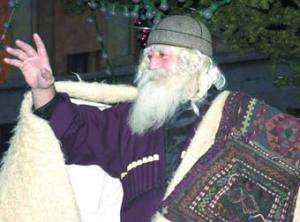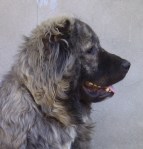It is New Year’s Eve and the busiest time of year for shops and markets and bakers. Everyone is preparing for the New Year feasts, which will begin after midnight tonight and continue well into the next day.
It is one of the most important celebrations of the year.
 Tables will be groaning beneath the weight of barbecued pork, roasted turkey, satsivi (chicken boiled in nut sauce), suckling pig, boiled and fried fish, fruit, nuts, salads, lobiani (bean bread), khachapuri (cheese bread), churchkhela (long strings of nuts dipped in grape juice), suluguni cheese, mchadi (corn bread) and cakes.
Tables will be groaning beneath the weight of barbecued pork, roasted turkey, satsivi (chicken boiled in nut sauce), suckling pig, boiled and fried fish, fruit, nuts, salads, lobiani (bean bread), khachapuri (cheese bread), churchkhela (long strings of nuts dipped in grape juice), suluguni cheese, mchadi (corn bread) and cakes.
 This will be accompanied by Georgian wine, traditionally drunk from ram or goat horns called kantsi.
This will be accompanied by Georgian wine, traditionally drunk from ram or goat horns called kantsi.
Some of the horns can take 2-3 litres of wine and it is traditional to drink the horn dry in one go!
Bread is an important part of the feasting and bakers have been working all night. People have been queuing outside our local baker since 5.00 a.m. this morning, each waiting to collect their 40 or 50 breads!
We were lucky. Our taxi driver (the one with the beautiful white Volga) collected our breads when he picked up his. He had been queuing for 6 hours!
 We will be thinking of family and friends at midnight. There is a tradition here called Mekvle (somebody who visits you first in the New Year). The appearance of a Mekvle, who wishes happiness, success and prosperity to everyone in the coming year, is a long standing tradition and is often performed by a family member who is let out for a few seconds to let him/her enter first and bring joy.
We will be thinking of family and friends at midnight. There is a tradition here called Mekvle (somebody who visits you first in the New Year). The appearance of a Mekvle, who wishes happiness, success and prosperity to everyone in the coming year, is a long standing tradition and is often performed by a family member who is let out for a few seconds to let him/her enter first and bring joy.
Georgian hospitality, generosity and love of life is famous. In fact, it goes back to the beginning!
“When God was distributing portions of the world to all the people of the Earth, the Georgians were having a party and doing some serious drinking. As a result, they arrived late and were told by God that all the land had been distributed. When they replied that they were late only because they had been lifting their glasses in praise of Him, God was pleased, and gave the Georgians that part of Earth He had been reserving for Himself.”
I wish all my friends a very happy and prosperous New Year. I wish I could be your Mekvle and be the first to greet the New Year with you.















